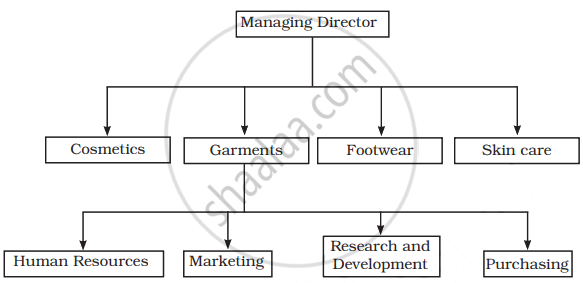Advertisements
Advertisements
प्रश्न
State its any two advantages of the divisional structure
State its any four advantages of divisional structure
Explain any four advantages of divisional structure.
उत्तर
Advantages of divisional structure:
1) Flexibility and Initiative: Under the divisional structure, each division functions independently. The divisional heads have the authority to take their own decisions. This promotes flexibility and initiative in the organisation.
2) Growth: Divisional structure enables easy growth and expansion of the organisation. This is because new divisions can be easily added without affecting existing divisions.
3) Managerial Efficiency: Under the divisional structure, each division is headed by a division head. The division head performs multiple functions for the division. In this way, he gets multiple opportunities for new experience and development. It helps in developing his skills and knowledge
4) Gauging Performance: Under the divisional structure, each division is responsible for its own profit and loss. In this way, the performance of each division of the organisation can be clearly evaluated, and so, necessary actions can be taken.
APPEARS IN
संबंधित प्रश्न
'My Car Ltd.' decided to set-up its new car manufacturing factory in the backward area of West Bengal where very less job opportunities were available. People of that area welcomed this effort of 'My Car Ltd.' The company also decided to provide facilities like school, hospital, market etc. in the factory premises so that the people are attracted to join the factory as workers.
'My Car Ltd.' started earning huge profit. Another competeting company asked its production manager 'Arvind' to investigate the reasons of earning huge profits by 'My Car Ltd.'
Arvind found that in both the companies there was systematic co-ordination among the various activities to achieve organisational goals. Every employee knew who was responsible and accountable to whom. The only difference was that in his organisation communication took place only through the scalar chain, where as 'My Car Ltd.' was allowing flow of communication in all the directions as per the requirement which lead to faster spread of information as well as quick feed-back.
a. Identify the type of organisation which permits the flow of communication in all the directions in 'My Car Ltd.'
b. Also state an advantage of the type of organisation identified in part (a) above.
c. State any two values which 'My Car Ltd.' wants to communicate to the society.
Name the organizational structure which helps in increasing managerial and operational efficiency.
Answer the following question:
Aradhana and Gandharv are heads of two different departments in 'Yumco Ltd.' 'They are efficient managers and are able to motivate the employee of their respective departments to improve performance. However, their drive to excel in their own sphere of activity instead of giving emphasis on objectives of the enterprise has hindered the interaction between the departments that Aradhana and Gandharv are heading. Often there are inter-departmental conflicts and they have become incompatible. This has proved to be harmful in the fulfillment of the organisational objectives. The situation has deteriorated to such an extent that the CEO of 'Yumco Ltd.' has hired a consultant, Rashmi, to resolve the problem. After studying the situation closely, Rashmi found that the problem has arisen due to inflexibility and a narrow perspective on the part of both Aradhana and Gandharv. She is of the view that this situation is a result of the type of organisational structure 'Yumco Ltd.’ has adopted.
From the above information, identify the organisational structure adopted by ‘Yumco Ltd.’ and state any three advantages of the structure so identified.
Differentiate between formal and informal organisation on the basis of origin.
Differentiate between formal and informal organization on the basis of the following:
Meaning
Differentiate between formal and informal organization on the basis of the following:
Authority
Differentiate between formal and informal organization on the basis of the following:
Nature
The differential between 'Functional and 'Divisional' structure of organising on the basis of the
following:
Formation
A differential between 'Functional and 'Divisional' structure of organising on the basis of the following:
Responsibility
A differential between 'Functional and 'Divisional' structure of organising on the basis of the following:
Cost involved
company has its registered office in Delhi, manufacturing unit at Gurgaon and marketing and sales department at Faridabad. The company manufactures the consumer products. Which type of organisational structure should it adopt to achieve its target?
What is a divisional structure? Discuss its advantages and limitations.
Differentiate between the functional organization and divisional organization
Which organisation structure does not have duplication of work?
Which of the following is not a merit of divisional structure?
Which type of organisational structure will you suggest for a firm which has diversified activities and operations requiring a high degree of specialisation?
Grouping of activities on the basis of product lines is a part of
Which of the following points highlight the suitability of functional structure?
Which statement is correct regarding division of work:

Identify the type of organization structure depicted in the above diagram:
